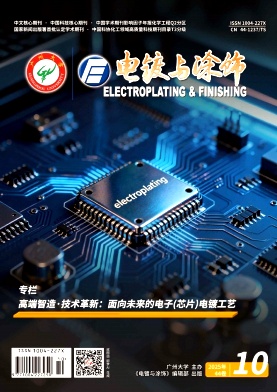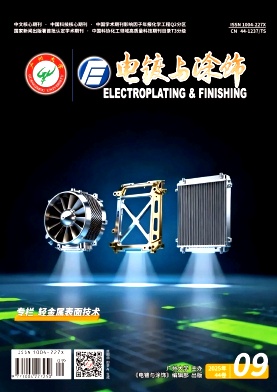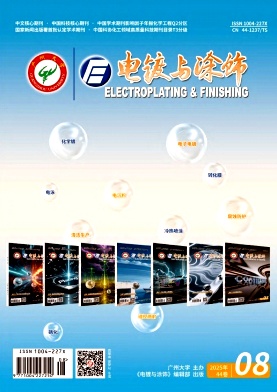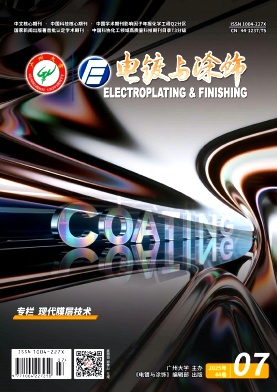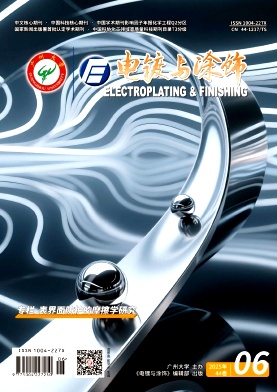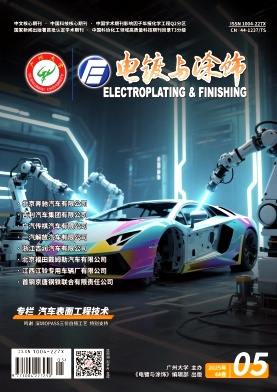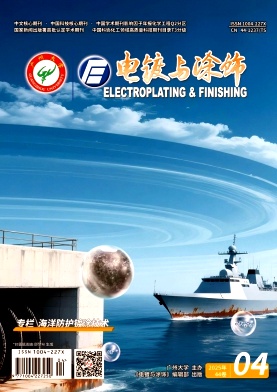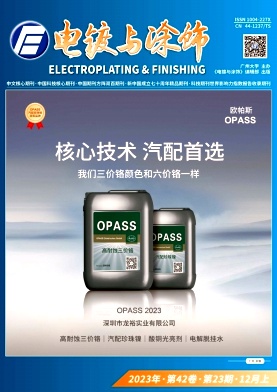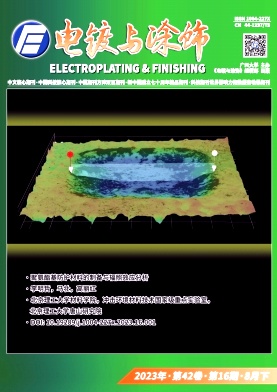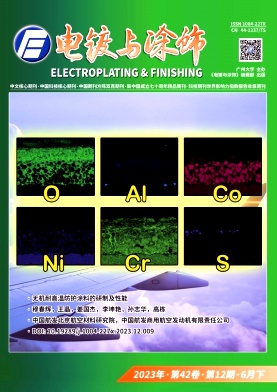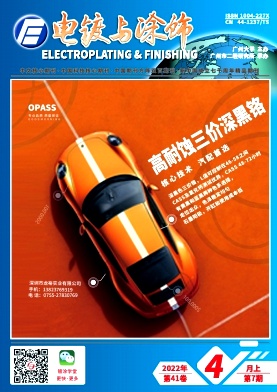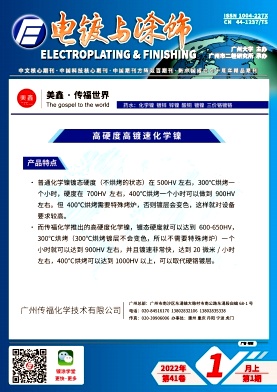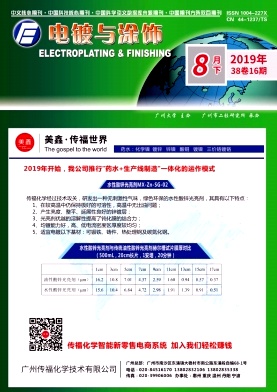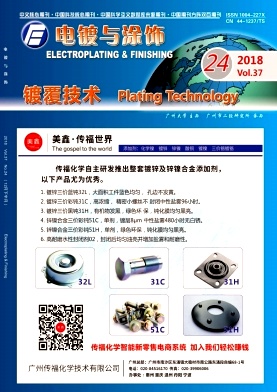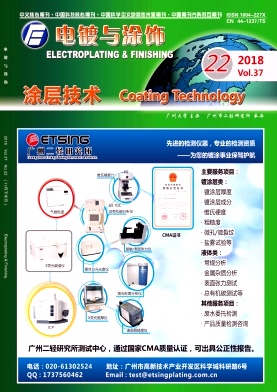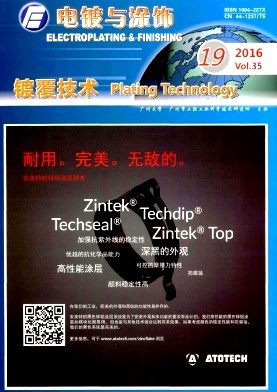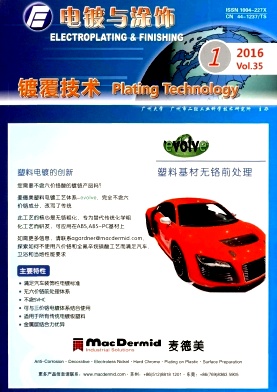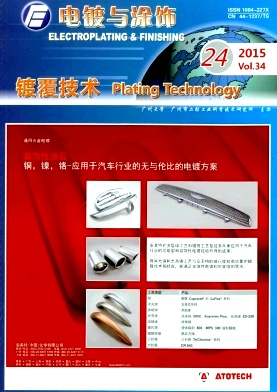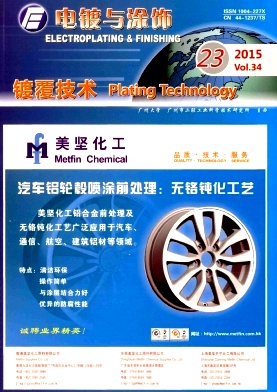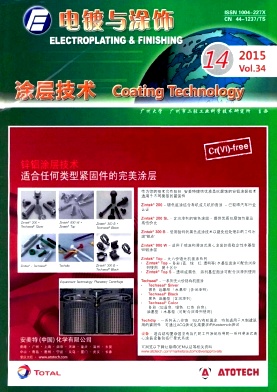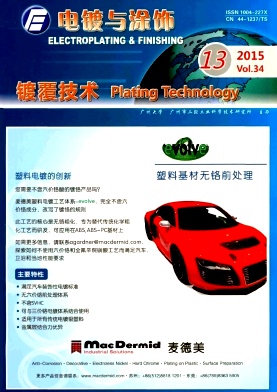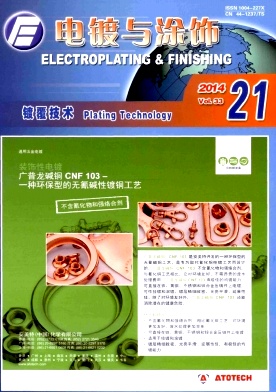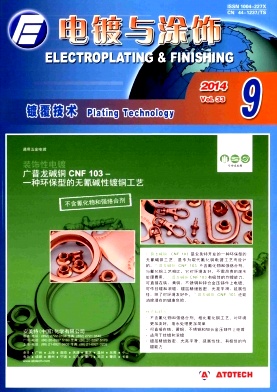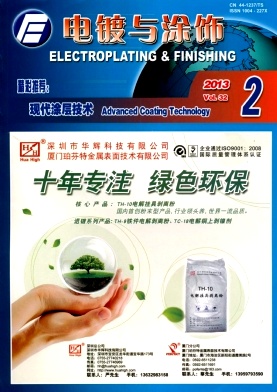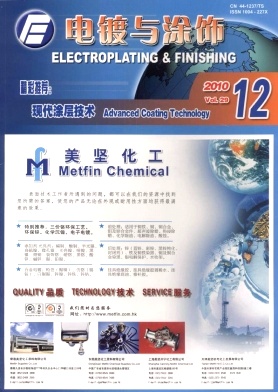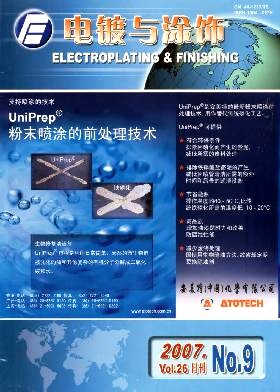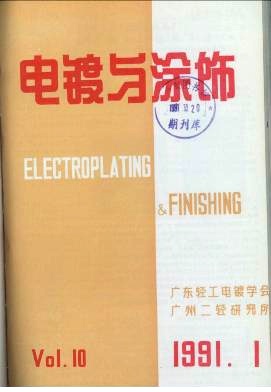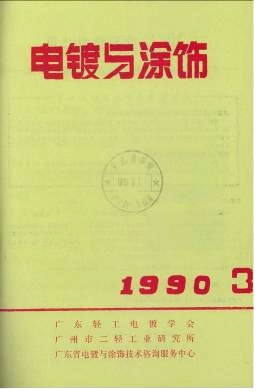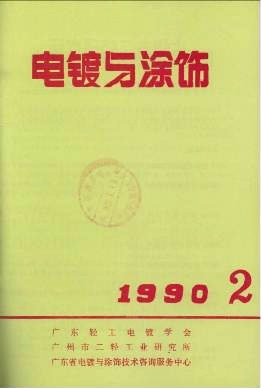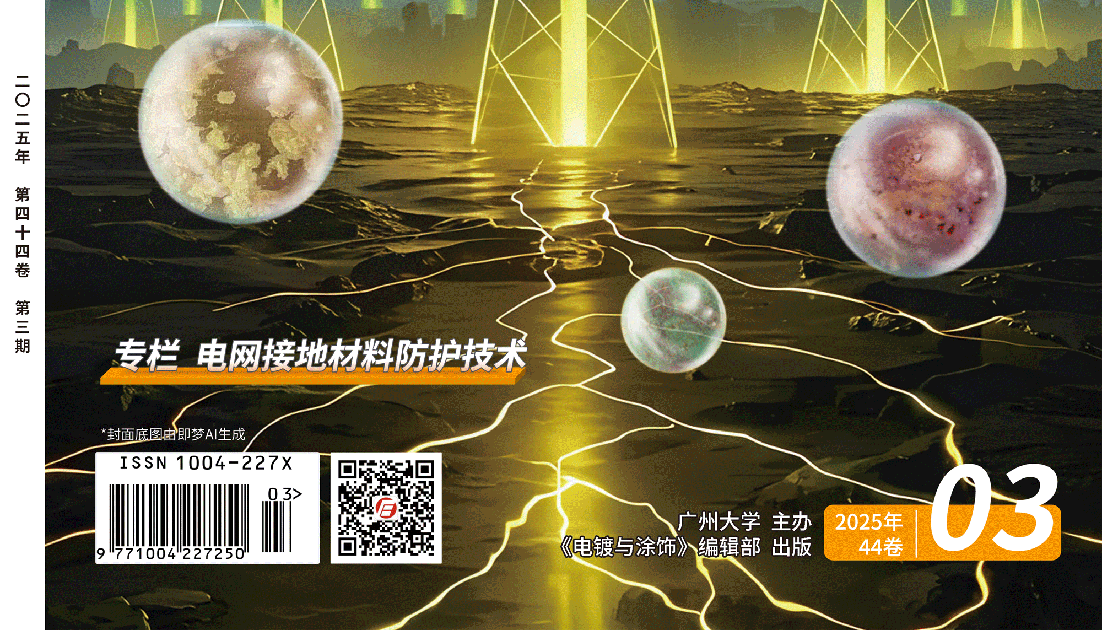Effect of stirring on microstructure and properties of trivalent chromium coatings on fine, thin, and long hooked-groove part
WANG Fashun;ZHU Shigen;GONG Wendi;DONG Weiwei;BAI Yunfeng;LUO Yilan;[Objective] Fine, thin, and long hooked-groove parts often encounter issues such as burnt coatings at fine hooks and skip-plating at inner wall of narrow-deep-long grooves during trivalent chromium electroplating, primarily due to uneven current density and solution mass transfer. [Method] Trivalent chromium electroplating was performed on fine, thin, and long hooked-groove parts in both stationary and agitated bath(stirring rate of 200, 400, or 600 r/min). The effects of agitation on the microstructure, adhesion, microhardness, and wear resistance of Cr coatings at different positions of the parts were studied by scanning electron microscopy(SEM), adhesion test, microhardness measurement, and friction-wear test. [Result] Appropriate agitation during electroplating significantly improved the distribution uniformity and microstructure of coatings across various part regions, consequently enhancing coating properties such as adhesion, microhardness, and wear resistance. [Conclusion] Bath stirring effectively resolved the problems of hook burning and groove skip-plating. A stirring rate of 400 r/min yielded chromium coatings that were uniform, compact, and smooth across all part areas, exhibiting the highest microhardness and the best wear resistance.
Preparation and properties of a highly corrosion-resistant gold coating
GUO Chongwu;LI Xiaohua;WANG Xiaojun;Guangdong Polytechnic Normal University;[Objective] A novel gold plating process for preparing highly corrosion-resistant coating was developed, aiming to address the critical issues of cyanide-based gold plating on zinc alloy die castings, such as severe environmental pollution, and insufficient overall corrosion resistance. [Method] A multi-layered coating was prepared on zinc alloy substrate through a sequential process involving cyanide-free copper–zinc alloy plating, pyrophosphate copper plating, acid copper plating, bright nickel plating, nickel–tin alloy plating, and strike gold plating on the zinc alloy die casting. [Result] By applying the strike gold plating over the high corrosion-resistant nickel–tin alloy layer, excellent interlayer adhesion was achieved. The obtained coating passed the thermal shock test without blistering or peeling, and withstood 240-hour neutral salt spray test without any signs of corrosion. [Conclusion] The newly developed process is environmentally friendly, can prepared coatings with superior performance at a relatively lower cost, demonstrating promising application prospects and significant market potential.
Effect of ion vapor deposition of aluminum on surface integrity and fatigue property of AISI 4340 steel
JIA Tianyi;BAO Qipeng;MAI Jiaqi;QIN Rui;YU Bo;ZHAN Zhongwei;AECC Beijing Institute of Aeronautical Materials;[Objective] The effect of ion vapor deposition(IVD) of aluminum on the surface integrity and fatigue property of AISI 4340 steel needs to be studied. [Method] Using tempered AISI 4340 steel as the substrate, aluminum coatings with thicknesses of 10 μm and 16 μm were deposited on the specimen surfaces via ion vapor deposition followed by sandblasting pretreatment. The microstructure, surface roughness, and residual stress distribution of specimens at different processing stages were compared by scanning electron microscopy(SEM), laser confocal microscopy(LCM), and X-ray residual stress analysis. The influencing mechanism of aluminum IVD on the fatigue property of AISI 4340 steel was analyzed. [Result] The surface roughness of substrate was significantly increased and numerous micro-pits were formed after sandblasting, which induced stress concentration under load, leading to a substantial decrease in fatigue performance(a reduction of 12.2%). A shallow residual compressive stress of approximately 200 MPa was formed on the surface. However, due to the plastic buffering effect of the aluminum layer, this stress did not affect the substrate surface. [Conclusion] The increased surface roughness and defect formation caused by sandblasting are the primary reasons for the degradation in fatigue performance, while the ion-plated aluminum coating has a relatively limited impact on AISI 4340 steel's fatigue properties.
Effect of hydrogen peroxide on corrosion resistance of electrolessly plated nickel–phosphorus alloy coating
XU Zhousheng;HU Guanghui;PAN Zhanchang;HE Nian;[Objective] The effects of hydrogen peroxide on the microstructure and corrosion resistance of electroless plated Ni–P alloy coatings were studied to improve their corrosion resistance. [Method] Different volume fractions(0-1.0 mL/L) of hydrogen peroxide were added to a basic electroless nickel plating bath. The deposition rate was analyzed by thickness measurement. The surface morphology, elemental composition, and phase structure of Ni–P alloy coatings were characterized using metallographic microscopy, scanning electron microscopy(SEM), energy-dispersive spectroscopy(EDS), and X-ray diffraction(XRD). The corrosion resistance of the coatings was evaluated through nitric acid spot test and electrochemical measurements. [Result] The addition of hydrogen peroxide reduced the deposition rate of electroless nickel plating and promoted a denser arrangement of cellular particles on the coating surface. The resulting Ni–P alloy coatings exhibited a phosphorus content in the range of 6%-9%(mass fraction) and an amorphous structure. As the volume fraction of hydrogen peroxide increased, the corrosion resistance of the coatings improved initially and then decreased, showing the best corrosion resistance at 0.6 mL/L. [Conclusion] The addition of an appropriate amount of hydrogen peroxide to the plating bath can effectively enhance the corrosion resistance of Ni–P alloy coatings, which is closely related to the coating density and phosphorus content.
Research progress in electroplating baths for nickel-and nickel alloy-based electroplated diamond wires
ZHANG Rong;ZHU Dongao;FAN Pengpeng;XU Lixian;CHEN Jialu;WU Jiqing;WANG Yicheng;JIANG Wei;LI Huaming;XU Hui;[Objective] Electroplated diamond wire serves as a critical tool in precision machining fields such as silicon wafer cutting, with its performance strongly correlated to how electroplating bath components affect diamond adhesion and coating uniformity. [Method] The research progress of three electroplating bath including chloride, sulfate, and sulfamate, for nickel and nickel alloy based electroplated diamond wires was reviewed. [Result] Optimizing the electroplating bath composition can facilitate directional attachment of diamond particles while improving coating uniformity and densification, thereby significantly enhancing the cutting efficiency and precision of diamond wires. [Conclusion] Future research should focus on developing environmentally friendly plating baths, decreasing cost, and improving electroplating efficiency to meet the demands of high-performance precision machining.
Effect of microstructure of 7A04 aluminum alloy forging on its anodization process
HAN Lei;PENG Jiangtao;WANG Jiangang;GUO Rui;WANG Shuaidong;[Objective] 7A04 aluminum alloy forgings are commonly used in the main load-bearing structures of the aerospace industry. Anodizing process is a commonly used surface treatment process for 7A04 aluminum alloy parts. Studying the influence of 7A04 aluminum alloy forging material structures for anodizing process is extremely important for guiding production. [Method] Surface alkali washing and anodizing process are made on the 7A04 joint forging after machining. The material structure and anodizing layer of the specimen are researched though energy spectrum analysis, metallographic analysis and micro-hardness testing analysis. [Result] After machining processes, alkali washing and anodizing were made to the 7A04 aluminum alloy forging test specimen. The test specimen showed different colors on both sides of the part. One side showed normal yellow color and the other showed abnormal black spots. During the free forging process, the material grains in the areas with small deformation and high forging rate are not fully refined, which has a certain impact on the mechanical properties. This leads to different surface flatness at both sides of the joint after alkali washing before anodizing. And it also makes different flatness of the final anodized film layer and differences in light reflection and scattering, leading to different colors. However, the anodized film layer at the location of the black spots on the surface is continuous and slightly smaller thickness, it can still provide some protection. [Conclusion] During the free forging process of 7A04 aluminum alloy, the deformation amount, forging speed, and cold forging deformation amount should be ensured to fully and uniformly refine the material structure. These can ensure that the quality of anodizing process and mechanical properties meet the requirements of engineering applications.
[Downloads: 0 ] [Citations: 0 ] [Reads: 0 ] HTML PDF Cite this article
Study on molybdenum disulfide slurry and its electrophoretic deposition process for threaded fasteners
SUN Xiaojun;LU Taiyu;WANG Furui;GUO Raolong;ZHENG Penghui;PENG Shusen;[Objective] Aiming to address the challenge of controlling coating thickness uniformity in local thread regions (thread crests/roots) of MoS2 coatings on small-sized externally threaded fasteners, [Method] this study developed a highly stable electrophoretic slurry by screening and processing MoS2 particles with specific sizes and optimizing their composite ratio with cathodic acrylic electrophoretic varnish. The influence patterns of electrophoretic voltage and bath temperature on coating thickness uniformity were systematically investigated, and the micro-morphology, thread-region thickness distribution, and tribological properties of electrophoretically deposited MoS2 coatings were comparatively studied against sprayed counterparts. [Result] Results demonstrate that the slurry formulated with 5% of 1-2 μm MoS2 powder and 20% cathodic acrylic electrophoretic varnish exhibits excellent dispersion stability. Under optimized conditions (electrophoretic voltage: 30-60 V, bath temperature ≤50℃), the obtained coatings display smooth and dense surfaces, with significantly superior coating thickness uniformity in thread regions compared to sprayed coatings. [Conclusion] The optimized cathodic electrophoretic deposition process enables the fabrication of MoS2 coatings with uniform thickness on small-sized threads, providing an effective technical solution for achieving homogeneous MoS2 coatings on small-sized threaded fasteners.
[Downloads: 0 ] [Citations: 0 ] [Reads: 0 ] HTML PDF Cite this article
Synthesis and characterization of hyperbranched castor oil-based UV-curable polyester coatings
WEN Jingyi;CHEN Xi;LI Zhuojun;WEI Daidong;XIE Zhihui;YONG Qiwen;[Objective] To address the dependence of conventional UV-curable coatings on petroleum-derived raw materials, this study employs renewable castor oil to formulate and optimize a hyperbranched castor oil–based UV-curable polyester coating and evaluates the influence of varying diluent contents on performance, aiming to establish a new sustainable route for eco-friendly polymer coatings; [Method] Castor oil hydroxyl groups were first reacted with 2,2-bis(hydroxymethyl)propionic acid to increase molecular branching, then terminal hydroxyls were esterified with maleic anhydride to introduce hydrophilicity; a hyperbranched prepolymer was subsequently synthesized via ring-opening addition of glycidyl methacrylate and characterized by FTIR and 1H-NMR; this prepolymer was formulated with 10, 20, and 30?wt% 2-hydroxyethyl methacrylate diluent into UV-curable systems, cast into films, and UV-cured; the resulting coatings were assessed for gel content, water uptake, contact angle, tensile properties, acid–alkali resistance, hardness, and adhesion; [Result] The formulation containing 20?wt% diluent exhibited optimal performance, achieving 86.57% gel content, 3.63% water uptake, a 75.16° water contact angle, 9.95?MPa tensile strength with 5.84% elongation at break, 80.40?HD hardness, and grade-1 adhesion; [Conclusion] The 20?wt% diluent system demonstrates excellent mechanical and weathering resistance, validating the feasibility of hyperbranched castor oil–based UV-curable polyester coatings and offering an effective sustainable strategy for high-performance, environmentally friendly polymer coatings.
[Downloads: 0 ] [Citations: 0 ] [Reads: 0 ] HTML PDF Cite this article
Application of large-size aerogel particles in waterborne aerogel thick thermal insulation intermediate paint
ZHAO Zhe;LIU Ju;ZHANG Kai;YANG Hehui;GONG Mengyu;GUO Xiaoqiang;[Objective] The research adopted the method of directly adding aerogel particles with a diameter of 0.6mm or larger to prepare waterborne aerogel thick thermal insulation intermediate paint, in order to replace the previous method of using a complex process to prepare a certain solid content aqueous slurry of 50um aerogel powder for use. This achieved the simplification of the production process of water-based aerogel insulation thick intermediate coating. [Method] Using aerogel particles as the insulation filler, acrylic emulsion as the film-forming material, hollow glass microbeads as the auxiliary insulation filler and the supporting framework of the thick coating, the effects of different particle sizes of aerogel particles and their dosages, different minimum film-forming temperatures of acrylic emulsion and their dosages, and different particle sizes of hollow glass microbeads and their dosages on the thermal conductivity, bonding strength and flexibility of water-based aerogel insulation thick intermediate coating were investigated. [Result] When using 30% Barduf acrylic emulsion B, 13% HL15 hollow glass microbeads and 7% aerogel particles with a particle size of 0.6mm, the various properties of the coating reached a balance, and the thermal conductivity was 0.03861 W/(K·m), and the bonding strength was 0.96 MPa, flexibility of at least 100 mm. [Conclusion] Compared with the waterborne aerogel thick thermal insulation intermediate paint made from the same mass of aerogel powder, the former not only has obvious advantages in performance, but also simplifies the production process and has certain market application value.
[Downloads: 0 ] [Citations: 0 ] [Reads: 0 ] HTML PDF Cite this article
Preparation of graphene oxide epoxy coating and study on its hydrogen barrier property
YU Zhenyue;SU Wei;SU Wenbo;CHEN Fuxin;RONG Yangyiming;[Objective] Hydrogen energy is considered to be the most promising secondary clean energy source today, but faces the problem of metal hydrogen embrittlement in transportation that needs to be solved. [Method] In this paper, 2,6-diaminopyridine was used to covalently modify graphene oxide (GO) by forming covalent bonds between amino groups and oxygen-containing groups such as carboxyl and epoxy groups of GO, and the resulting BGO was mixed with epoxy resin to prepare BGO/EP composite coatings, which were designed to improve its hydrogen-blocking properties, as well as its good corrosion resistance and adhesion. [Result] The results of XRD and infrared spectroscopy showed that 2,6-diaminopyridine successfully modified graphene oxide. The electrochemical results showed that the impedance value of the BGO/EP composite coating could reach 108 Ω·cm2 with high interfacial reaction resistance and good corrosion resistance. Hydrogen permeation as well as hydrogen content tests showed that the addition of BGO reduced the ip of pure EP from 3.62 μA·cm2 to 0.61 μA·cm2, and the hydrogen flux and hydrogen diffusion coefficient were significantly reduced, resulting in a 95% reduction of hydrogen permeation. [Conclusion] BGO/EP coatings effectively block and inhibit hydrogen penetration, providing a new path for the design of high-performance hydrogen-blocking anti-corrosion coatings.
[Downloads: 0 ] [Citations: 0 ] [Reads: 0 ] HTML PDF Cite this article
Development and application of thermal spraying technology
WANG Yong-bing, LIU Xiang, QI Wen-jun LI Zhi-guo: College of Mechanical Engineering Xinjiang University, Urumchi 830008, ChinaThe technics characteristic of thermal spraying technology was introduced. Advantages and disadvantages of five kinds of thermal spraying technologies including high velocity oxygen fuel flame spraying process, hypersonic plasma spray process, laser spray process, reactive spray process and cold gas dynamic spray process were analyzed. Application status of thermal spray process was summarized. The prospect of new technics and materials application to thermal spraying technology was discussed.
[Downloads: 4,514 ] [Citations: 176 ] [Reads: 21 ] HTML PDF Cite this article
Characteristics, applications and research direction of micro-arc oxidation technology
ZHONG Tao-sheng~(1,2), JIANG Bai-ling~2, LI Jun-ming~2 (1. School of Applied Science, Jiangxi University of Technology, Ganzhou 341000, China; 2. Institute of Material Science and Engineering, Xi'an Industry University, Xi'an 710048, China)Research status and development of nano-material electrodeposition
DENG Shu hao, GONG Zhu qing, CHEN Wen gu (Dept. of Metallurgical Science and Engineering, Zhongnan Univ., Changsha 410083, China)Preparation of nano-metal nano alloy and nano complex material by electrodeposition was reviewed, as well as structure characteristics, excellent properties of the deposit and its application forecast.
Development status of pulse current plating
XIANG Guo-pu (Dept. of Appl. Chemistry., Tianjin Univ., Tianjin 300072, China)Application status of pulse current plating in chromium, copper, nickel and its alloy, gold and its alloy, silver and its alloy, palladium and its alloy electroplating were summarized. Pulse reverse plating, composite pulse plating and amorphous alloy pulse plating were also described.
Treatment of hexavalent chromium-containing electroplating wastewater by barium salt precipitation
LI Hang-bin;QIAN Bo;HUANG Cong-cong;CHEN Xin-cai;ZHANG Shi-xin;LIU Xiang-hu;Hexavalent chromium-containing electroplating wastewater was treated by barium salt precipitation. The effects of pH pre-adjustment of wastewater, cyanide decomposition method, and addition of Cr(VI) precipitator on the removal of hexavalent chromium, total chromium, copper, and nickel were studied. The influence of the dosage of sulfuric acid on the recovery of hexavalent chromium was examined. The optimal process parameters for treatment of hexavalent chromium-containing electroplating wastewater by barium salt precipitation are as follows: pre-adjusted pH 8,barium salt dosage 2.5 times of the theoretical value, cyanide decomposition with hydrogen peroxide, and final pH 10 adjusted with liquid caustic soda. After treating under the optimal process conditions, the total chromium content and nickel content in effluent is 0.4 mg/L and 0.3 mg/L, and no copper is detected, all of which are below the emission limits of Table 2 in the GB 21900–2008 standard. The recovery of hexavalent chromium in barium chromate sediment reaches 65% by solid–solid transformation using sulfuric acid. The costs for reagent and treatment of hazardous solid waste by barium salt precipitation are higher than those of traditional chemical reduction. Barium salt precipitation is suitable for professional chrome plating factories and plating industrial parks where chromium wastewater is strictly discharged and collected individually.
Development and application of thermal spraying technology
WANG Yong-bing, LIU Xiang, QI Wen-jun LI Zhi-guo: College of Mechanical Engineering Xinjiang University, Urumchi 830008, ChinaThe technics characteristic of thermal spraying technology was introduced. Advantages and disadvantages of five kinds of thermal spraying technologies including high velocity oxygen fuel flame spraying process, hypersonic plasma spray process, laser spray process, reactive spray process and cold gas dynamic spray process were analyzed. Application status of thermal spray process was summarized. The prospect of new technics and materials application to thermal spraying technology was discussed.
[Downloads: 4,514 ] [Citations: 176 ] [Reads: 21 ] HTML PDF Cite this article
Current status of research on waterborne polyurethane coatings
ZENG Xian-guang;GONG Min;LIU Chao-hui;ZHANG Ying-jun;ZHANG Jing-yu;The film formation mechanism of waterborne polyurethane coating was briefly described. The current status of the research on preparation and modification of one-and two-component waterborne polyurethane coatings was introduced. The development trends of waterborne polyurethane coatings were pointed out.
Principle, application and research prospect of electroless copper plating
LI Neng-bin, LUO Wei-yin, LIU Jun-quan, XU Jin-lai College of Industrial Equipment and Control Engineering, South China University of Technology, Guangzhou 510640, ChinaElectroless copper plating is mainly applied to the metallization for PCB and electroplating on plastics, and copper electroless deposits have good ductibility, heat conductivility and electrical conductibility. Its application scope and development were introduced. This paper also emphasizes the necessity for pretreatment of electroless copper plating and some aspects that need attention including using grease that is easy to be cleaned as antirust agent and anodic electrolytic degreasing for low-carbon steel parts, and combined acidic decreasing and alkaline decreasing, etc. Some commonly used systems and their main components of electroless copper plating were introduced. The influences of additives were discussed. The research progress of electroless copper plating for nonmetal was reported. The research keystones of copper electroless plating were presented.
Research progress of electropolishing technology
ZHANG Su-yin,DU Kai,CHEN Jia-jun,ZHAN Yong-jun,ZENG Ti-xian School of Physics and Electronic Information,West China Normal University,Nanchong 637002,ChinaThe current status,characteristic and polishing principle of electropolishing technology were introduced. The main factors affecting workpiece’s surface roughness are analyzed. The existing problems in electropolishing technology are presented.
[Downloads: 3,714 ] [Citations: 97 ] [Reads: 44 ] HTML PDF Cite this article
Current status and development trend of domestic and world coating industry(Ⅰ)——Current stastus and development trend of worldwide coating industry
ZHAO Jin-bang Shanghai Research Institute of Paint &Coatings,Shanghai 200062,ChinaAn overview was given of the current status of world coating industry.The worldwide application and research status of low contamination and pollution-free water-base coating,powder coating,non-solvent coating and high-solid coating etc,and environment contribution coating,function coating(including fluorocarbon resin coating,spraying polyuridylic elastomer,organic-inorganic composite coating,high ornamental coating,stealth coating and intelligent coating) etc,and nanomaterial applied to the coating were summarized.Development trend was presented.
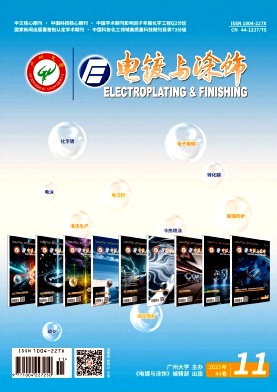
Tracking the information about your manuscript
Communicate with the editorial office
Query manuscript payment status Editor officeCollecting, editing, reviewing and other affairs offices
Managing manuscripts
Managing author information and external review Expert Information Peer ReviewOnline Review
Online Communication with the Editorial Department
Downloads
Links
Editorial Board
Telephone: 020-39366085
E-mail: plating@gzhu.edu.cn
Address: 230 Wai Huan Xi Road, Guangzhou Higher Education Mega Center, Guangzhou, China
Page Views
Technical Topic
Protection Technology for Grounding Materials in Power Grids | Paper
Alternating current corrosion behavior of copper-clad steel in acidic soil Effect of DC stray current on corrosion behavior of copper in red soil Effects of multiple anion coexistence on corrosion behavior of grounding metals in soil of Jilin region Macrocell corrosion behaviors of four grounding materials induced by oxygen concentration difference in soil Corrosion behavior of hot-dip galvanized bolts in different atmospheric environments and environmental performance evaluation Long-term corrosion behaviors of five grounding materials in neutral salt spray environment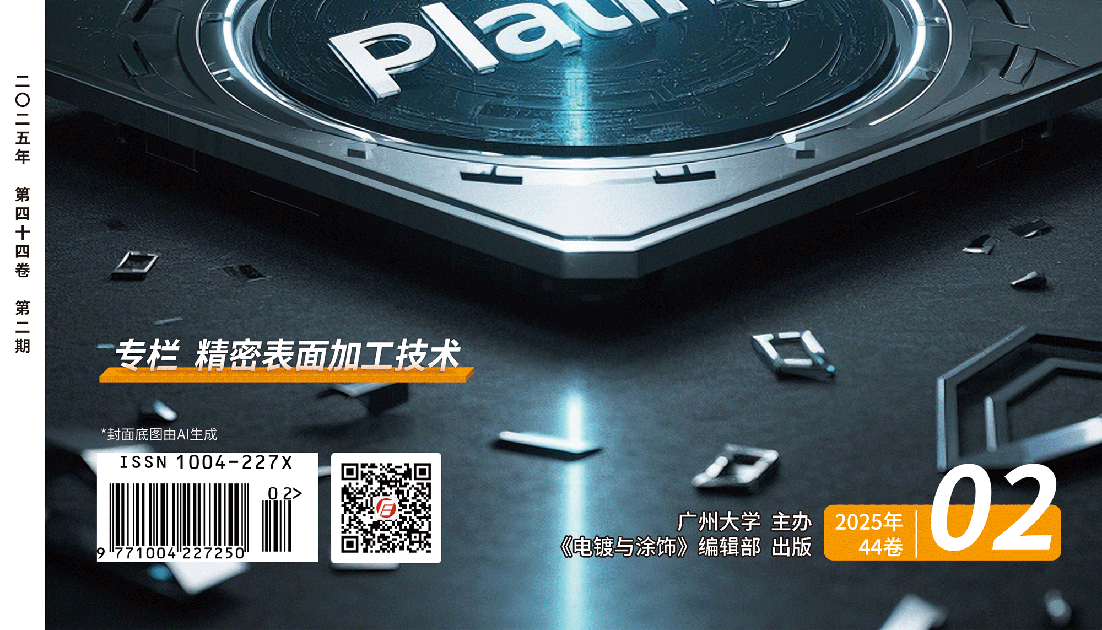
Album Precision Surface Machining Technology
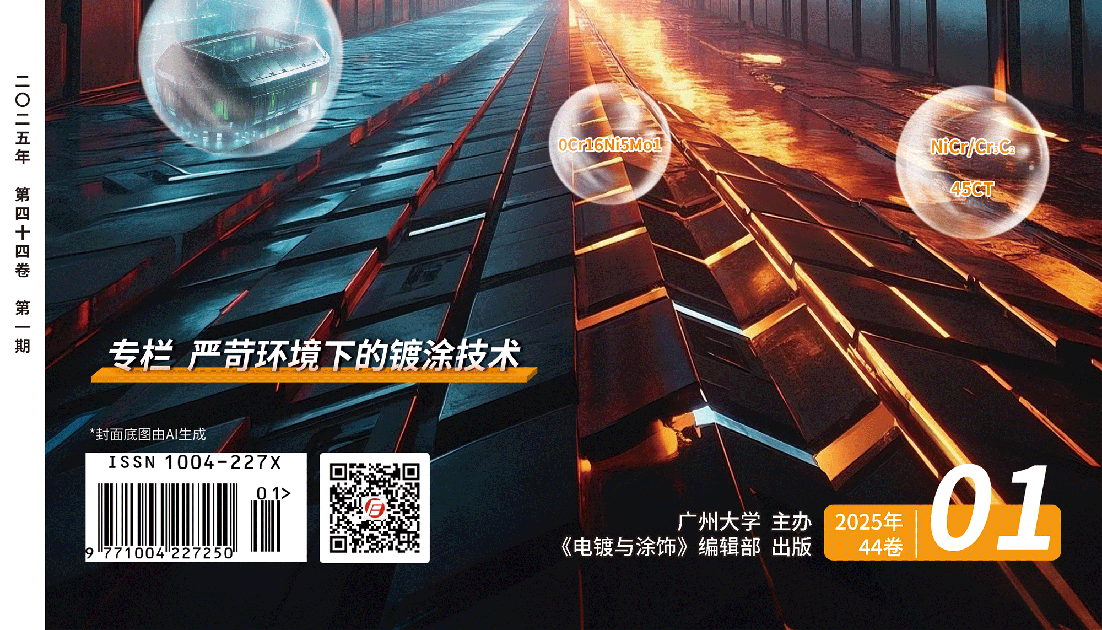
Album Plating & Coating Technologies for Harsh Environments
